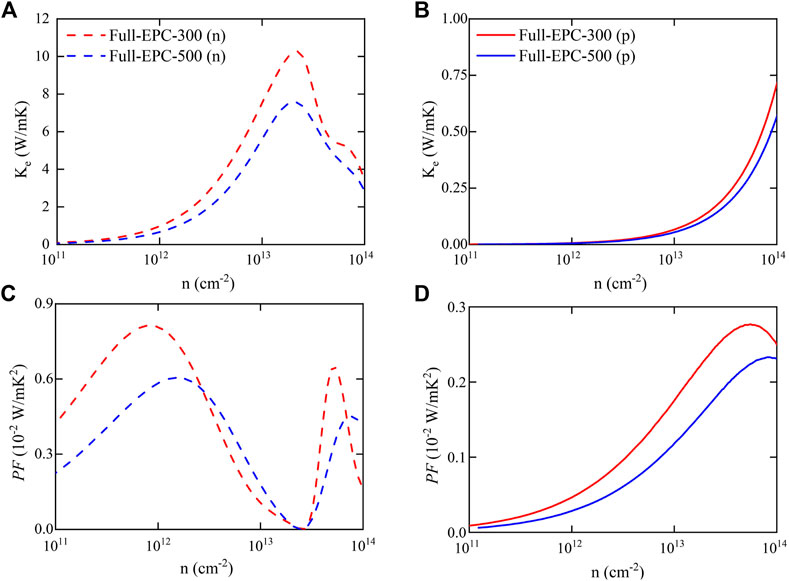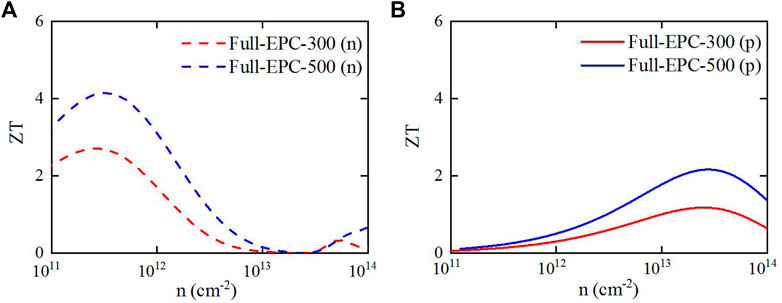- 1School of Physics and Electronic Science, Guizhou Normal University, Guiyang, China
- 2Key Laboratory of Low Dimensional Condensed Matter Physics of Higher Educational Institution of Guizhou Province, Guizhou Normal University, Guiyang, China
Thermoelectric (TE) materials with an excellent thermoelectric figure of merit (ZT) provide an effective way to alleviate energy pressure and protect the environment. By applying the first-principles method, this paper makes a systematic study of the electronic and phonon transport properties of two-dimensional (2D) novel TlInSe3 utilizing the Boltzmann transport theory (BTE). The calculation results reveal that 2D TlInSe3 has an excellent power factor (0.81 × 10−2 W/mK2) and ultra-low lattice thermal conductivity (0.46 W/mK) at 300 K. We find that the low phonon group velocity and strong anharmonicity are the main factors leading to the ultra-low lattice thermal conductivity of TlInSe3. Meanwhile, by discussing the acoustic-optical scattering, we attribute low phonon group velocity and strong anharmonicity to the increase of scattering rates between acoustic mode and optical mode, which further suppresses the lattice thermal conductivity. In the analysis of electron and phonon transport properties, 2D TlInSe3, as a novel TE material, exhibits a ZT value as high as 4.15 at 500 K. Our research results show that TlInSe3 is a potential TE material, and the relevant analysis is significant in exploring new TE materials.
1 Introduction
The thermoelectric effect enables the conversion of waste heat to electrical energy, while the conversion efficiency of thermoelectric (TE) materials can be evaluated by the thermoelectric figure of merit (ZT) value, demonstrated in the formula: ZT =
Recent research has shown that thallium (Tl) compounds possess intrinsically ultra-low lattice thermal conductivity (
This work employs the Boltzmann transport theory (BTE), taking TlInSe3 as a typical example, to study its electron and phonon transport properties combined first principles. Our research shows that, at room temperature, TlInSe3 has a ZT value of up to 4.15 at 500 K and an ultra-low
2 Computational and theoretical methods
We perform density functional theory (DFT) calculations using the QUANTUM ESPRESSO (QE) code [33, 34]. To obtain the relaxation structure and energy band structure, we use the kinetic energy of 70 Ry, the k-points of 16 × 16 × 1; and the energy convergence standard is 10−9 Ry, while the force convergence standard is 10−8 Ry. 16 × 16 × 1 k-points and 8 × 8×1 q-points are set to calculate phonon dispersion based on density functional perturbation theory (DFPT) [35, 36]. Meanwhile, based on periodic boundary conditions, in the 2D TlInSe3 z-direction, we set a vacuum layer of 35 Å to prevent out-of-plane interactions. By working out the phonon Boltzmann transport equation, the
In addition, to determine convergence, we tested the mobility using dense k-points, as demonstrated in Supplementary Figure S2A,B, which show that holes using 160 × 160 × 1 k-points and q-points can achieve convergence, while for electrons, it is necessary to use 480 × 480 × 1 k-points and a q point of 160 × 160 × 1 to ensure convergence.
In PERTURBO,
In the above equation,
where
where μ is the chemical potential and T is the temperature. The electronic thermal conductivity is obtained by the formula
where
3 Results and discussions
The top and side drawings of the novel 2D TlInSe3 are plotted in Figure 1A. The 2D TlInSe3 is a hexagonal structure and is the P-3m1 space group. The optimized lattice constant is 4.17 Å, which is in agreement with the results in the literature [20, 42, 43]. Figure 1B shows the phonon spectrum of the novel 2D TlInSe3. Since 2D TlInSe3 has no imaginary frequency, its structure is dynamically stable. Meanwhile, we have tested the energy with different k-points, and compared the phonon dispersion by using the q points of 7 × 7 × 1 and 9 × 9 × 1, and found no difference, indicating that the phonon spectrum is convergent, as shown is Supplementary Figure S3A,B. At the same time, It is noteworthy that near the
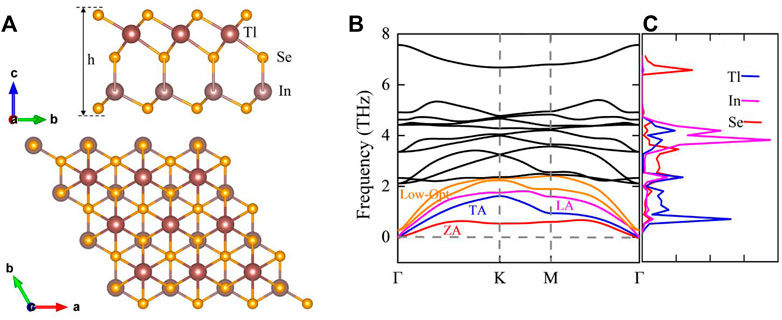
FIGURE 1. (A) Relaxed structure of 2D TlInSe3, h is effective thickness, (B) phonon band plots where the red line represents the ZA mode, the blue line the TA mode, the magenta line the LA mode, the orange line the low-frequency optical mode, and the black line the high-frequency optical mode, and (C) DOS for 2D TlInSe3.
Moreover, we study further the cohesive energy (Ecoh) of TlInSe3, whose formula is as follows:
Among them, N represents the number of atoms of each element, E is the energy of a single atom of each element, and ETlInSe3 is the total energy of 2D TlInSe3. The calculated Ecoh is 0.32 eV, indicating that its structure is energetically favorable.
The ab initio molecular dynamics (AIMD) has been simulated using a 3 × 3 supercell at different temperatures with a time setting of 5 ps and a time step of 1 fs. Due to the small fluctuation in the total energy, the atomic structure exhibits only a small deviation from its equilibrium position at 300 and 500 K. These studies show that 2D TlInSe3 is stable at 300 and 500 K. However, at 700 K, as shown in Supplementary Figure S4, there is significant distortion with large fluctuations in energy, and the TlInSe3 monolayer is unstable.
Figure 2A shows the electronic energy bands of TlInSe3 without considering the w-SOC (with the spin-orbit coupling). Meanwhile, it shows that the energy band structure of TlInSe3 has a double degeneracy at the
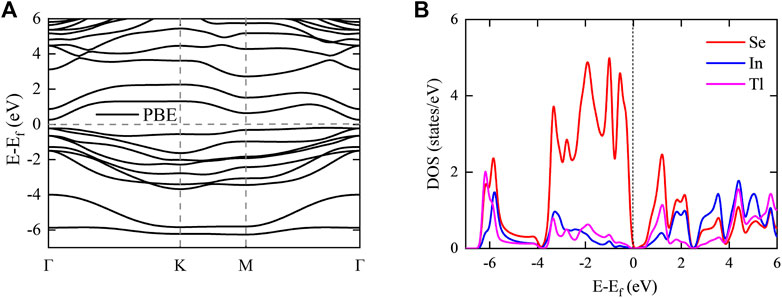
FIGURE 2. (A) The band structures without SOC, and (B) projected density of states of 2D TlInSe3, respectively.
The electron transport coefficients of TlInSe3 are obtained by solving the Boltzmann transport equation (BTE). The electron conductivity (σ) and the Seebeck coefficient (S) as a function of the carrier concentration from 300–500 K are demonstrated in Figures 3A–D. The calculation results clearly show that the σ of n-type doping is an order of magnitude, that is, higher than that of p-type doping, as presented in Figures 3A, B. For n-type doping, σ first arises and then goes down with carrier concentration because of the sudden drop in mobility at high concentrations when considering electron-phonon (el-ph) coupling, which was also reported in previous literature [44–47]. The TlInSe3 monolayer shows a large S (absolute value) under n-type and p-type doping, as displayed in Figures 3C, D. Moreover, the S (absolute value) of 2D p-type TlInSe3 is all higher than that of n-type due to the smoother VBM relative to CBM, resulting in a larger effective carrier mass. Moreover, according to the band convergence strategy, the band degeneracy can further enhance S (
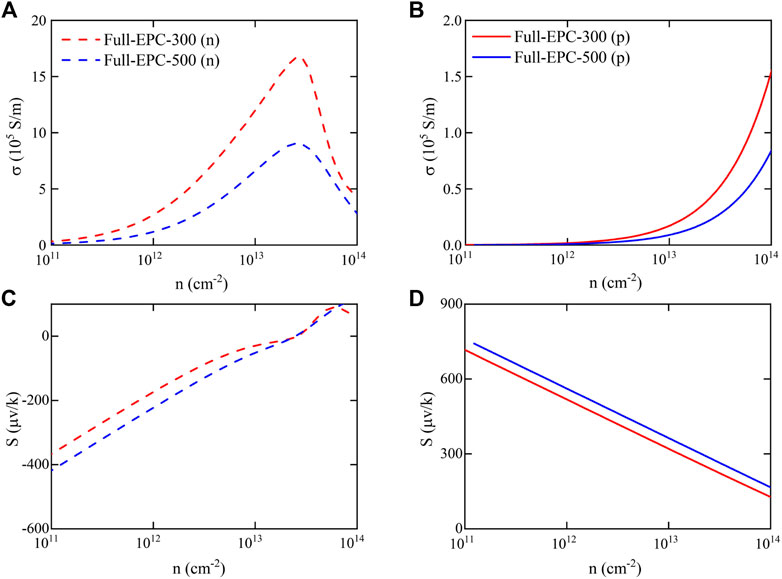
FIGURE 3. (A,B) Conductivity
Figure 4 displays the calculated results of the electronic thermal conductivity (
Phonons are considered chief carriers for heat transportation in semiconductors and insulators. Here, the
where
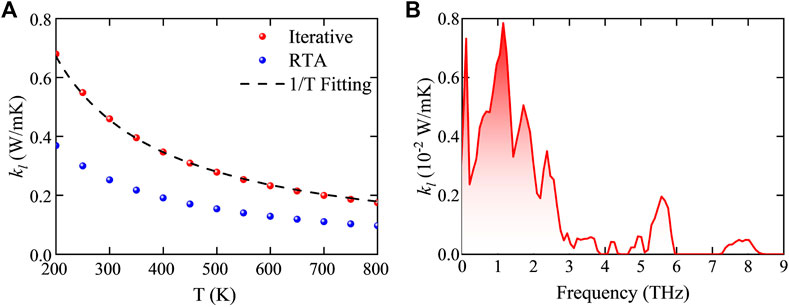
FIGURE 5. (A) The
According to Eq. 5, it can be known that the phonon group velocity
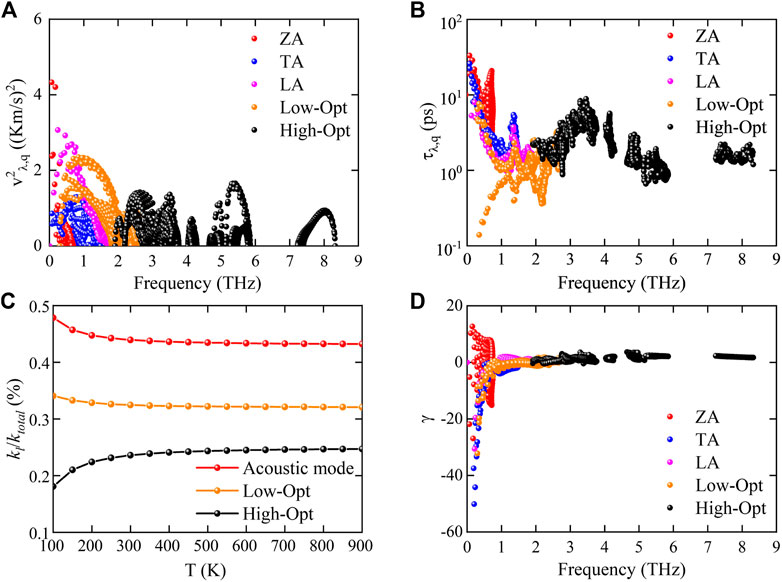
FIGURE 6. (A) The
According to the phonon and electron transport properties, the thermoelectric conversion efficiency (ZT) of the new 2D TlInSe3 is obtained, as plotted in Figure 7. In Figure 7A, n-type TlInSe3 has an outstanding ZT value of up to 4.15 at 500 K. The ZT values of TlInSe3 are more advantageous than the related materials reported from the literature, such as In2Se3 (2.8), TlSe (1.94), and TlInTe2 (2.6). Compared with the ZT of p-type TlInSe3 at 500 K (2.16), the ZT of n-type TlInSe3 at 300 K is more promising. Such high thermoelectric conversion efficiency benefits from ultra-low
4 Conclusion
Overall, we investigate the TE performance of novel two-dimensional TlInSe3 by the first-principles method. By working out the BTE (Boltzmann transport equation), the study reveals that the 2D TlInSe3 possesses an ultra-low
Data availability statement
The original contributions presented in the study are included in the article/Supplementary Material, further inquiries can be directed to the corresponding author.
Author contributions
XY: calculation, writing—original draft, visualization. LZ: calculation, writing—original draft, visualization. QW: formal analysis, suggestion, visualization. YL: suggestion, visualization. BL: writing—review and editing, suggestion, software, visualization. All authors contributed to the article and approved the submitted version.
Funding
This work is supported by the Guizhou Provincial Science and Technology Foundation [Grant no. (2019) 1225].
Conflict of interest
The authors declare that the research was conducted in the absence of any commercial or financial relationships that could be construed as a potential conflict of interest.
Publisher’s note
All claims expressed in this article are solely those of the authors and do not necessarily represent those of their affiliated organizations, or those of the publisher, the editors and the reviewers. Any product that may be evaluated in this article, or claim that may be made by its manufacturer, is not guaranteed or endorsed by the publisher.
Supplementary material
The Supplementary Material for this article can be found online at: https://www.frontiersin.org/articles/10.3389/fphy.2023.1172989/full#supplementary-material
References
1. Gao Z, Wang J-S. Thermoelectric penta-silicene with a high room-temperature figure of merit. ACS Appl Mater.Interfaces (2020) 12:14298–307. doi:10.1021/acsami.9b21076
2. Pei Y, Wang H, Snyder GJ. Band engineering of thermoelectric materials. Adv Mater (2012) 24:6125–35. doi:10.1002/adma.201202919
3. Kim J, Shim W, Lee W Bismuth nanowire thermoelectrics. J Mater Chem C (2015) 3(46), 11999–2013. doi:10.1039/c5tc02886h
4. Pei Y, Shi X, LaLonde A, Wang H, Chen L, Snyder GJ. Convergence of electronic bands for high performance bulk thermoelectrics. Nature (2011) 66-69:66–9. doi:10.1038/nature09996
5. Gao Z, Tao F, Ren J Unusually low thermal conductivity of atomically thin 2D tellurium. Nanoscale (2018) 10, 12997–3003. doi:10.1039/c8nr01649f
6. Madsen GK, Singh DJ. BoltzTraP. A code for calculating band-structure dependent quantities. Comput Phys Commun (2006) 175:67–71. doi:10.1016/j.cpc.2006.03.007
7. Ding G, He J, Cheng Z, Wang X, Li S. Low lattice thermal conductivity and promising thermoelectric figure of merit of zintl type TlInTe2. J Mater Chem C (2018) 6:13269–74. doi:10.1039/c8tc03492c
8. Matsumoto H, Kurosaki K, Muta H, Yamanaka S. Systematic investigation of the thermoelectric properties of TlMTe2 (M= Ga, in, or Tl). J Appl Phys (2008) 104:073705. doi:10.1063/1.2987471
9. Jana MK, Pal K, Warankar A, Mandal P, Waghmare UV, Biswas K. Intrinsic rattler-induced low thermal conductivity in zintl type TlInTe2. J Am Chem Soc (2017) 139:4350–3. doi:10.1021/jacs.7b01434
10. Dutta M, Matteppanavar S, Prasad MV, Pandey J, Warankar A, Mandal P, Soni A, Waghmare UV, Biswas K. Ultralow thermal conductivity in chain-like TlSe due to inherent Tl+ rattling. J Am Chem Soc (2019) 141:20293–9. doi:10.1021/jacs.9b10551
11. Qiu B, Ruan X. Thermal conductivity prediction and analysis of few-quintuple Bi2Te3 thin films: A molecular dynamics study. Appl Phys Lett (2010) 97:183107. doi:10.1063/1.3514252
12. Kurosaki K, Yamanaka S. Low-thermal-conductivity group 13 chalcogenides as high-efficiency thermoelectric materials. Wiley Online Libr (2013) 210:82–8. doi:10.1002/pssa.201228680
13. Guo Q, Chan M, Kuropatwa B, Kleinke H. Enhanced thermoelectric properties of variants of Tl9SbTe6 and Tl9BiTe6. Chem Mater (2013) 25:4097–104. doi:10.1021/cm402593f
14. Sankar CR, Bangarigadu-Sanasy S, Assoud A, Kleinke H. Syntheses, crystal structures and thermoelectric properties of two new thallium tellurides: Tl4ZrTe4 and Tl4HfTe4. J Mater Chem (2010) 20:7485–90. doi:10.1039/c0jm01363c
15. Patel A, Singh D, Sonvane Y, Thakor P, Ahuja R. High thermoelectric performance in two-dimensional janus monolayer material WS-X (X= Se and Te). ACS Appl Mater Inter (2020) 12:46212–9. doi:10.1021/acsami.0c13960
16. Minhas H, Das S, Pathak B. Ultralow thermal conductivity and high thermoelectric performance of γ-GeSe: Effects of dimensionality and thickness. ACS Appl Energ Mater (2022) 5:9914–28. doi:10.1021/acsaem.2c01600
17. Ning S, Huang S, Zhang T, Zhang Z, Qi N, Chen Z. Two-dimensional β-PdX2 (X= S, Se, and Te) monolayers with promising potential for thermoelectric applications. J Phys Chem C (2022) 126:17885–93. doi:10.1021/acs.jpcc.2c06186
18. Majumdar A, Chowdhury S, Ahuja R. Drastic reduction of thermal conductivity in hexagonal AX (A= Ga, in and Tl, X= S, Se and Te) monolayers due to alternative atomic configuration. Nano Energy (2021) 88:106248. doi:10.1016/j.nanoen.2021.106248
19. Majumdar A, Chowdhury S, Ahuja R. Ultralow thermal conductivity and high thermoelectric figure of merit in two-dimensional thallium selenide. ACS Appl Energ Mater (2020) 3:9315–25. doi:10.1021/acsaem.0c01658
20. Nian T, Wang Z, Dong B. Thermoelectric properties of α-in2Se3 monolayer. Appl Phys Lett (2021) 118(2021):033103. doi:10.1063/5.0036316
21. Zhao L-D, Lo S-H, Zhang Y, Sun H, Tan G, Uher C, Wolverton C, Dravid VP, Kanatzidis MG. Ultralow thermal conductivity and high thermoelectric figure of merit in SnSe crystals. Nature (2014) 508:373–7. doi:10.1038/nature13184
22. Sun G, Qin X, Li D, Zhang J, Ren B, Zou T, Xin H, Paschen SB, Yan X. Enhanced thermoelectric performance of n-type Bi2Se3 doped with Cu. J Alloy Compd (2015) 639:9–14. doi:10.1016/j.jallcom.2015.03.124
23. Mi W, Qiu P, Zhang T, Lv Y, Shi X, Chen L. Thermoelectric transport of Se-rich Ag2Se in normal phases and phase transitions. Appl Phys Lett (2014) 104:133903. doi:10.1063/1.4870509
24. Wickramaratne D, Zahid F, Lake RK. Electronic and thermoelectric properties of van der Waals materials with ring-shaped valence bands. J Appl Phys (2015) 118:075101. doi:10.1063/1.4928559
25. Zheng Y, Tang X, Wang W, Jin L, Li G Large-size ultrathinα-Ga2S3 nanosheets toward high-performance photodetection. Adv Funct Mater , 2008307,31(2021). doi:10.1002/adfm.202008307
26. Jeengar C, Tomar M, Jindal K, Sharma A, Jha PK. Influence of post deposition annealing on thermoelectric properties of In2Se3 thin films. Mater Sci Semicond Process (2023) 153(2023):107127. doi:10.1016/j.mssp.2022.107127
27. Li B, Zhang C, Sun Z, Han T, Zhang X, Du J, Wang J, Xiao X, Wang N. The potential thermoelectric material Tl3XSe4 (X= V, Ta, Nb): A first-principles study. Phys Chem Chem Phys (2022) 24:24447–56. doi:10.1039/d2cp00358a
28. Yang J, Li J, Zhang C, Feng Z, Shi B, Zhai W, Yan Y, Wang Y. Excellent thermoelectric performance of BaMgSi driven by low lattice thermal conductivity: A promising thermoelectric material. J Alloy Compd (2020) 827:154342. doi:10.1016/j.jallcom.2020.154342
29. Babich AV, Rogachev M. Investigation of thermal properties and thermal stability of the Sn-Pb-Te system materials for the thermoelectric generator application. Proceeding of the 2020 IEEE Conference of Russian Young Researchers in Electrical and Electronic Engineering (EIConRus). January 2020, St. Petersburg and Moscow, Russia. IEEE (2020). 2111–4.
30. Zhan S, Hong T, Qin B, Zhu Y, Feng X, Su L, Shi H, Liang H, Zhang Q, Gao X, et al. Realizing high-ranged thermoelectric performance in PbSnS2 crystals. Nat Commun (2022) 13:5937. doi:10.1038/s41467-022-33684-0
31. Xia Q, Xu Q, Xu B, Yi L. Ab initio prediction of thermoelectric performance of monolayer BiSbTe3. J Solid State Chem (2021) 296:121963. doi:10.1016/j.jssc.2021.121963
32. Gangwar VK, Kumar S, Singh M, Ghosh L, Yufeng Z, Shahi P, Patil S, Schwier EF, Shimada K, Uwatoko Y. Pressure induced superconductivity and location of Fermi energy at Dirac point in BiSbTe3 (2019). arXiv preprint arXiv:1906.10336.
33. Giannozzi P, Andreussi O, Brumme T, Bunau O, Nardelli MB, Calandra M, Car R, Cavazzoni C, Ceresoli D, Cococcioni M, et al. Advanced capabilities for materials modelling with quantum ESPRESSO. J Phys Condens Matter (2017) 29:465901. doi:10.1088/1361-648X/aa8f79
34. Perdew JP, Zunger A. Self-interaction correction to density-functional approximations for many-electron systems. Phys Rev B (1981) 23:5048–79. doi:10.1103/physrevb.23.5048
35. Baroni S, Gironcoli SD, Corso AD, Giannozzi P. Phonons and related crystal properties from density-functional perturbation theory. Rev Mod Phys (2001) 73:515–62. doi:10.1103/revmodphys.73.515
36. Gonze X. First-principles responses of solids to atomic displacements and homogeneous electric fields: Implementation of a conjugate-gradient algorithm. Phys Rev B (1997) 55:10337–54. doi:10.1103/physrevb.55.10337
37. Li W, Carrete J, Katcho NA, Mingo N. ShengBTE: A solver of the Boltzmann transport equation for phonons. Comput Phys Commun (2014) 185:1747–58. doi:10.1016/j.cpc.2014.02.015
38. Lu I-T, Zhou J-J, Park J, Bernardi M. First-principles ionized-impurity scattering and charge transport in doped materials. Phys Rev Mater (2022) 6:L010801. doi:10.1103/PhysRevMaterials.6.L010801
39. Peng P-P, Wang C, Li L-W, Li S-Y, Chen Y-Q. Research status and performance optimization of medium-temperature thermoelectric material SnTe. Chin Phys B (2022) 31(2022):047307. doi:10.1088/1674-1056/ac20c9
40. Gupta R, Dongre B, Carrete J, Bera C. Thermoelectric properties of the SnS monolayer: Fully ab initio and accelerated calculations. J Appl Phys (2021) 130:054301. doi:10.1063/5.0058125
41. Zhou J-J, Park J, Lu I-T, Maliyov I, Tong X, Bernardi M. Perturbo: A software package for ab initio electron–phonon interactions, charge transport and ultrafast dynamics. Comput Phys Commun (2021) 264:107970. doi:10.1016/j.cpc.2021.107970
42. Hieu NN, Phuc HV, Kartamyshev A, Vu TV. Structural, electronic, and transport properties of quintuple atomic janus monolayers Ga2SX2 (X= O, S, Se, Te): First-principles predictions. Phys Rev B (2022) 105:075402. doi:10.1103/physrevb.105.075402
43. Zhang G, Lu K, Wang Y, Wang H, Chen Q. Mechanical and electronic properties of α− M2X3 (M= Ga, in; X= S, Se) monolayers. Phys Rev B (2022) 105:235303. doi:10.1103/PhysRevB.105.235303
44. Chen Y, Wu Y, Hou B, Cao J, Shao H, Zhang Y, Mei H, Ma C, Fang Z, Zhu H, et al. Renormalized thermoelectric figure of merit in a band-convergent Sb2Te2Se monolayer: Full electron–phonon interactions and selection rules. J Mater Chem A (2021) 9:16108–18. doi:10.1039/d1ta02107a
45. Marfoua B, Hong J. High thermoelectric performance in hexagonal 2D PdTe2 monolayer at room temperature. ACS Appl Mater.Interfaces (2019) 11:38819–27. doi:10.1021/acsami.9b14277
46. Cheng L, Liu H, Zhang J, Wei J, Liang J, Shi J, Tang X. Effects of van der Waals interactions and quasiparticle corrections on the electronic and transport properties of Bi2Te3. Phys Rev B (2014) 90:085118. doi:10.1103/physrevb.90.085118
47. Sheng C, Fan D, Liu H. High thermoelectric performance can be achieved in two-dimensional (PbTe)2 layer. Phys Lett A (2020) 384:126044. doi:10.1016/j.physleta.2019.126044
48. Batsanov SS. Van der Waals radii of elements. Inorg Mater (2001) 37:871–85. doi:10.1023/A:1011625728803
49. Gao Z, Dong X, Li N, Ren J. Novel two-dimensional silicon dioxide with in-plane negative Poisson’s ratio. Nano Lett (2017) 17:772–7. doi:10.1021/acs.nanolett.6b03921
50. Yuan K, Sun Z, Zhang X, Gong X, Tang D A first-principles study of the thermoelectric properties of rhombohedral GeSe. Phys Chem Chem Phys 22, 1911, 22. doi:10.1039/c9cp05153h2020).
51. Lv B, Hu X, Wang N, Song J, Liu X, Gao Z Thermal transport property of novel two-dimensional nitride phosphorus: An ab initio study. Appl Surf Sci (2021) 559, 149463. doi:10.1016/j.apsusc.2021.149463
52. Peng B, Zhang H, Shao H, Xu Y, Zhang X, Zhu H Low lattice thermal conductivity of stanene. Sci Rep ,6, 20225, doi:10.1038/srep202252016).
Keywords: first-principles calculation, ultra-low lattice thermal conductivity, phonon anharmonicity, 2D TlInSe3, high thermoelectric performance
Citation: Yin X, Zhou L, Wang Q, Liao Y and Lv B (2023) High thermoelectric performance of TlInSe3 with ultra-low lattice thermal conductivity. Front. Phys. 11:1172989. doi: 10.3389/fphy.2023.1172989
Received: 24 February 2023; Accepted: 17 March 2023;
Published: 03 April 2023.
Edited by:
San-Dong Guo, Xi’an University of Posts and Telecommunications, ChinaCopyright © 2023 Yin, Zhou, Wang, Liao and Lv. This is an open-access article distributed under the terms of the Creative Commons Attribution License (CC BY). The use, distribution or reproduction in other forums is permitted, provided the original author(s) and the copyright owner(s) are credited and that the original publication in this journal is cited, in accordance with accepted academic practice. No use, distribution or reproduction is permitted which does not comply with these terms.
*Correspondence: Bing Lv, bHZiaW5nQGd6bnUuZWR1LmNu
†These authors have contributed equally to this work and share first authorship
 Xixi Yin
Xixi Yin Lang Zhou1,2†
Lang Zhou1,2† Bing Lv
Bing Lv